Phoenix—CEO Ken Goodrich of Goettl Air Conditioning and Plumbing, a leading provider of HVAC and plumbing services in the Southwest United States, announced he is spending $1.5 million to install Ultra Violet (UV) germicidal lights in the homes of more than 600 employees. Deemed an essential business during an unprecedented time in our nation, Goettl’s Read more
HVAC
 Phoenix—CEO Ken Goodrich of Goettl Air Conditioning and Plumbing, a leading provider of HVAC and plumbing services in the Southwest United States, announced he is spending $1.5 million to install Ultra Violet (UV) germicidal lights in the homes of more than 600 employees.
Phoenix—CEO Ken Goodrich of Goettl Air Conditioning and Plumbing, a leading provider of HVAC and plumbing services in the Southwest United States, announced he is spending $1.5 million to install Ultra Violet (UV) germicidal lights in the homes of more than 600 employees.
Deemed an essential business during an unprecedented time in our nation, Goettl’s HVAC and plumbing technicians have continued to work tirelessly to ensure their community is receiving essential life systems and services throughout the COVID-19 pandemic. To show appreciation for their hard work and dedication, Goodrich is giving each Goettl employee a new UV germicidal light that will be installed into their personal HVAC system.
“Our technicians are putting their own well-being and safety second to serve their communities,” said Goodrich. “I want them to know how much we appreciate their unwavering dedication and bravery by giving them a product that will hopefully provide their own families with invaluable peace of mind during these uncertain times.”
The UV germicidal light, which mimics natural sunlight, uses ultraviolet radiation to drastically decrease indoor germs such as mold, fungi and bacteria. Additionally, the UV radiation destroys the nuclei of each contaminant preventing it from reproducing. Proven to kill viruses of many strains, this type of UV light is also used in hospitals and food processing plants nationwide.
The safety and well-being of Goettl employees is top priority for Goodrich and his executive team. As technicians are a critical resource for essential home services, Goodrich is committed to doing as much as possible to help ensure they stay safe and healthy during this public health crisis.
“At Goettl, we believe in doing things the right way, not the easy way and what’s right is keeping our employees safe and as healthy as possible so that they may continue to serve their beloved communities,” Goodrich continued.

Dallas — Flashback to the year 1945. A 17-year-old Robert Tiner becomes the youngest master plumber in the state of Texas. Mr. Tiner lays the foundation for what will evolve into one of the most reputable home-service providers in Dallas-Fort Worth. Originally Mr. Tiner partnered with two brothers whose last name was actually Baker, he and his team focused Read more
Dallas — Flashback to the year 1945. A 17-year-old Robert Tiner becomes the youngest master plumber in the state of Texas. Mr. Tiner lays the foundation for what will evolve into one of the most reputable home-service providers in Dallas-Fort Worth. Originally Mr. Tiner partnered with two brothers whose last name was actually Baker, he and his team focused on providing quality plumbing while the Baker brothers specialized in insurance. After several successful years of growth Mr. Tiner bought the company outright but kept the Baker Brothers name as an ode to his former business partners and to continue to build the brand in the local area. Now in its third generation of being a family-owned-and-operated, Baker Brothers is pleased to announce the celebration of its 75th anniversary. From 1945 to present day, Baker Brothers has continued to proudly serve the community with the same type of superior quality service originally envisioned by Mr.Tiner.
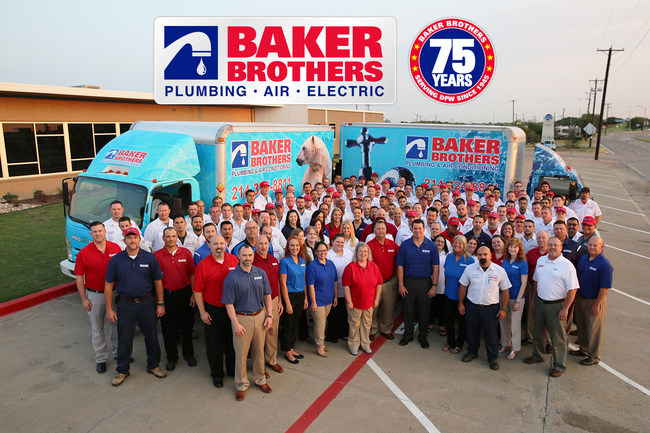
Baker Brothers Plumbing, Air, & Electric
In honor of this milestone anniversary, Baker Brothers will conduct a year-long campaign to captivate the customers and the community that have made the company successful for so many years. Baker Brothers will share its extensive history over the course of the year through its initiative – 75 Days of Baker. This campaign will feature stories on the history of the company, as well as special limited-time offers for customers. In addition, Baker Brothers and its employees will be collecting and donating a total of 7,500 cans for local charities, Dallas Life and North Texas Food Bank.
Through the years the company has expanded its specialties from plumbing to now include heating and cooling services as well as electrical services. The Baker Brothers’ legacy continues by staying committed to its core values of “Trust, Quality, and Care” to ensure customer and employee satisfaction. Baker Brothers is home to 262 employees that strive to make customers feel like family by meeting their needs at the highest level. It is also part of the mission of Baker Brothers to give back to the community it serves and beyond, by partnering with various charities to help feed the homeless, draw water wells in Africa, and volunteer resources to no-kill animal shelters.
Third-generation company president, Jimmie Dale Jr. says of the anniversary “It is with great pride that I can say we’ve been in business for 75 years! Since our inception in 1945 as a small plumbing company specializing in leak locates, we were the first plumbing company to utilize a camera to help locate the leaks. Seventy-five years later the same spirit of innovation and relentless commitment to customer service allows us to not only meet the plumbing needs of our customers but also provide additional services in HVAC and Electrical.”
The Baker Brothers family is grateful for the opportunities it’s had to serve and make a difference in the lives of others in the community.
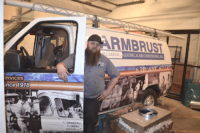
A quick jobsite visit to the western suburbs of Chicago found hydronics guru Alan Carlson (Instagram @alan_carlson) swapping out leaking boilers at an 80-unit apartment complex. Carlson, a plumbing and heating industry veteran has been repping the trades for the past 19 years. He entered the plumbing trade back in 2001, and for the past Read more
A quick jobsite visit to the western suburbs of Chicago found hydronics guru Alan Carlson (Instagram @alan_carlson) swapping out leaking boilers at an 80-unit apartment complex.
Carlson, a plumbing and heating industry veteran has been repping the trades for the past 19 years. He entered the plumbing trade back in 2001, and for the past few years now, he has moved over to the hydronics side of the job with Ambrust Plumbing & Heating Solutions, Carol Stream, Ill., to where—back in 2014—he took his plumbing skills. Since 1918, Armbrust has provided DuPage County residents exceptional residential/commercial plumbing and heating services.
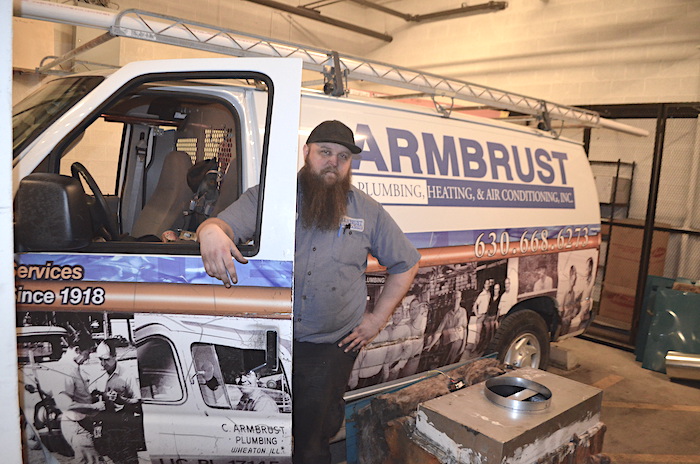
Carlson is testament to hard work and dedication to his craft. “I knew I wasn’t cut out for college and the trades has afforded me the opportunity to make a good living and provide for my family,” says Carlson.
Alan takes great pride in his work and it shows with the finished product. “I am a hard-working, goal-oriented person who specializes in problem solving, job quality and customer satisfaction.”
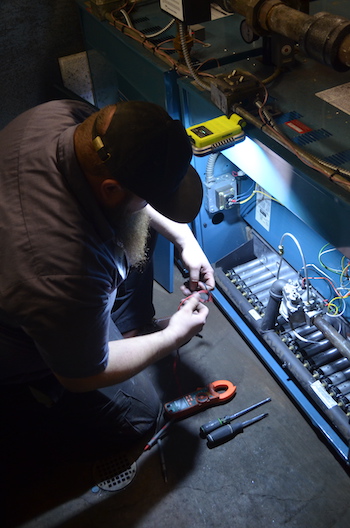 And don’t take his word for it, read what customers are saying about Alan and his professionalism. According to an online review, “This is the second time I have had Alan C. over to check on our plumbing. He is always friendly and very knowledgeable. He has a considerable level of experience and he has been able to answer all of my questions. When presented with options for needed services, he is honest in giving feedback with absolutely no pressure. Armbrust is a great plumbing company.”
And don’t take his word for it, read what customers are saying about Alan and his professionalism. According to an online review, “This is the second time I have had Alan C. over to check on our plumbing. He is always friendly and very knowledgeable. He has a considerable level of experience and he has been able to answer all of my questions. When presented with options for needed services, he is honest in giving feedback with absolutely no pressure. Armbrust is a great plumbing company.”
Carlson was introduced to the trades at a very early age because his great grandfather, C.J. Erickson, started one of the oldest, and still one of the most successful, plumbing businesses in Chicago. In 1906, Carl Joseph “Joe” Erickson immigrated to America from Sweden, settling in Chicago. Joe, an accomplished plumber, signed with Plumbers Local 130 and set out to live the American dream, opening his own shop.
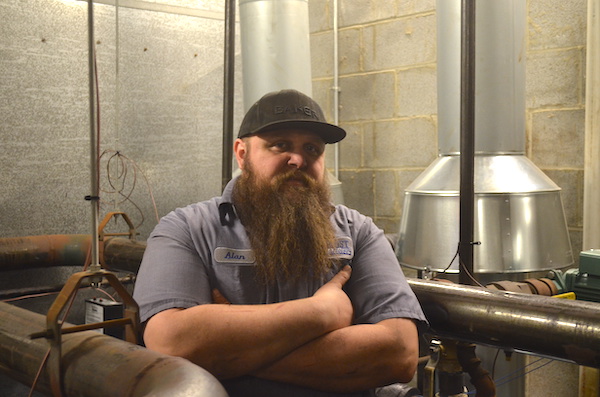
Although Carlson never worked at his great grandfather’s shop in the city, he got a taste early in his youth of what working in the trades would be like. “I didn’t know what career I wanted after high school. I tried the local junior college without any direction, hoping I would magically find something. I didn’t even finish a year. I decided that if my family can run a successful plumbing company in Chicago for four generations, and if my neighbor who owns his own company can make a good living, I would try plumbing,” says Carlson.

The trades have enriched Carlson’s life because he now possesses important and highly desired skills. “I also have a better understanding and much higher respect for those who work physically hard to earn their wage,” says Carlson.
Carlson stresses that there never should be a negative stereotype attached to being in the trades. “Having a career in the trades does not mean that you’re dumb or dirty or should be looked down upon. A trade is a highly skilled and highly needed job. If you want to have a career where you will always be needed, regardless of the economy, become a plumber. And if you do decide to get into it, work hard, never stop learning and never stop asking questions; be the first one there and the last one to leave,” says Carlson.
Irving, Texas—The Plastics Pipe Institute, Inc. (PPI) has renewed its commitment for financial and technical support for the 2020 U.S. Department of Energy (DOE) Solar Decathlon – Design Challenge. PPI is the major North American trade association representing all segments of the plastic pipe industry. This is PPI’s sixth year supporting this DOE program, formerly Read more
Irving, Texas—The Plastics Pipe Institute, Inc. (PPI) has renewed its commitment for financial and technical support for the 2020 U.S. Department of Energy (DOE) Solar Decathlon – Design Challenge. PPI is the major North American trade association representing all segments of the plastic pipe industry. This is PPI’s sixth year supporting this DOE program, formerly known as Race to Zero.
The 2020 Solar Decathlon Design Challenge will take place at DOE’s National Renewable Energy Laboratory (NREL) in Golden, Colorado on April 17-19, 2020. Lance MacNevin, P.Eng, director of engineering for PPI’s Building & Construction, will return as a juror.

A student from the University of Missouri – Columbia shows a scale model for the Mixed-Use/Multifamily category at the 2019 Solar Decathlon – Design Challenge in Golden, Colo. Photo credit: DOE Solar Decathlon
According to MacNevin, “Buildings in the United States represent 4o% of our country’s total energy consumption and 70% of our electricity use, so there are many opportunities to utilize existing technologies in smart ways to reduce energy costs. At these events, we see future architects and engineers collaborate and compete to design houses and buildings that are so energy efficient that their annual energy use can be offset with renewable energy.”
DOE’s website states, “Qualifying teams complete a design project and attend the Solar Decathlon Design Challenge Weekend, where they present their designs to a panel of industry expert jurors, compare their projects to those of other teams, learn from presentations by thought leaders and collegiate peers, and engage with a variety of organizations about energy careers. Winning teams are recognized at an Awards Banquet, and winning project presentations are published on the website.” https://www.solardecathlon.gov/event/challenges-design.html
PPI President David Fink said, “PPI encourages design teams to incorporate innovative plumbing and mechanical systems to improve the health, safety and welfare of building occupants and the efficiency of buildings. This includes technologies such as hydronic radiant heating and cooling, ground source geothermal, hot- and cold-water plumbing using plastic piping solutions, and fire protection for occupant safety. These systems can benefit the entries in practically all categories of judging, including energy performance, engineering, architecture, market appeal, financial affordability, operation, comfort & environmental quality, and innovation.”
Added MacNevin, “It’s always so exciting to see the creative designs and technological ideas of the student teams from around the world. We can’t wait to see what they’ll present at the 2020 event!”
PPI has developed resources to help students design their projects available at https://plasticpipe.org/building-construction/bcd-2020-solar-decathlon.html
For additional information, also visit the Plastics Pipe Institute’s website at: www.plasticpipe.org.

This paper refers to legal professional cannabis growers complying with state/provincial laws. Professional cannabis growers are well aware that environmental conditions play a critical role in plant quality and overall yield. Most can recite the ideal temperature and humidity for their crops without missing a beat. But ask most growers which type of pipe is Read more
This paper refers to legal professional cannabis growers complying with state/provincial laws.
Professional cannabis growers are well aware that environmental conditions play a critical role in plant quality and overall yield. Most can recite the ideal temperature and humidity for their crops without missing a beat. But ask most growers which type of pipe is best and they’ll likely to refer you to the closest head shop. The fact is professional growers (of cannabis or otherwise) are generally unaware of the piping options they have or the extent to which these options impact structural costs, energy efficiency and overall sustainability. When these matters are given proper consideration, polypropylene emerges as a great choice for this burgeoning industry.
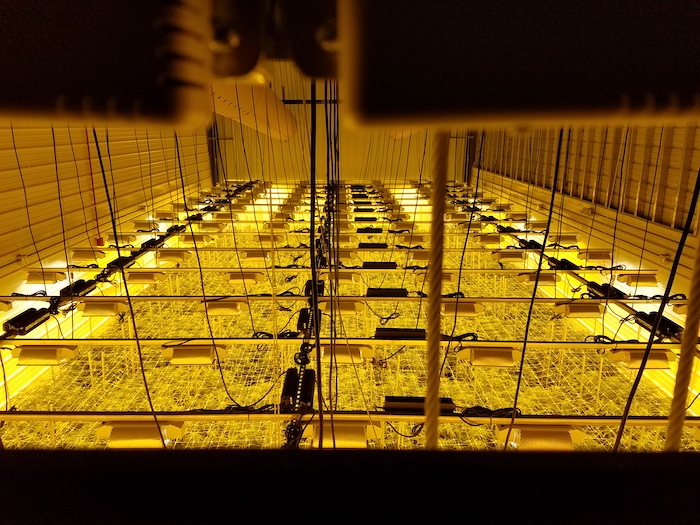
Cannabis growing facilities use a lot of energy and generate a lot of heat, making a reli- able cooling system essential.
Polypropylene pipe has been widely used for plumbing and hydronic heating in Europe since the 1970s. However, it was not introduced to North America until 2005. Since then, it has become increasingly popular for a wide range of applications, from radiant heating of sports fields to process applications in craft breweries. It is a lightweight yet highly durable thermoplastic pipe with pressure and temperature tolerances that make it suitable for hydronic heating and cooling, potable water, and industrial and food-grade applications.
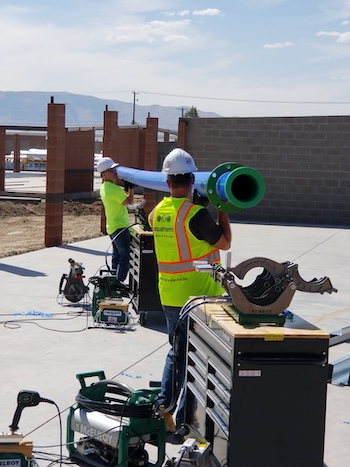
Depending on size and wall thickness, polypropylene pipe can weigh up to 70% less than carbon steel pipe.
Unlike metal pipe, the installation of polypropylene pipe does not involve traditional torch welding. Instead it relies on a flameless heat-fusion method that’s easy to learn and highly reliable at creating virtually leak-free connections. When contractors become adept at heat fusion, they can typically install polypropylene piping much faster than welding copper, carbon steel and stainless-steel pipe.
An appealing characteristic of polypropylene is its chemical purity and inertness. It does not rust, scale or leach any impurities into to the fluids it transports, nor does it react with most chemicals. This not only improves its longevity over other piping materials, it also makes it suitable for a wide range of applications. Furthermore, unlike PVC or CPVC piping, polypropylene pipe does not become brittle or susceptible to cracking when exposed to cold temperatures. A full list of the physical/performance characteristics of polypropylene and associated benefits is shown in Table 1.
 Where does polypropylene fit into the day-to-day operation of a grow facility? The answer is pretty much any application that requires the transport of fluids. But to truly understand the potential roles that polypropylene can play in the growing cannabis industry, one must first look at the special needs, challenges and values of the industry.
Where does polypropylene fit into the day-to-day operation of a grow facility? The answer is pretty much any application that requires the transport of fluids. But to truly understand the potential roles that polypropylene can play in the growing cannabis industry, one must first look at the special needs, challenges and values of the industry.
An Energy Intensive Industry
The electrical demand of cannabis grow facilities is staggering. According to the 2018 Cannabis Energy Report, legal cannabis cultivation in the U.S. consumes an estimated 1.1 terawatt-hours of electricity a year, enough to power all of Newark, New Jersey or Anaheim, California.[1] In indoor grow facilities — very often repurposed warehouses or other types of vacant buildings —this massive energy consumption is caused by the artificial light required to grow cannabis. Heat from these lights imposes another energy burden: cooling. Year-round cooling loads are unavoidable in indoor facilities since carefully controlled space temperatures are essential for growers to achieve maximum yields. Greenhouse facilities may avoid most of the need for artificial light, but still need heating, cooling and dehumidification. In either case, large facilities benefit from the long-term efficiency of centralized hydronic heating and/or cooling systems, which are typically about 15 percent to 20 percent more efficient than other HVAC options.[2] These systems utilize piping to transport the heating water to and from a central boiler system and to transport cooling water to and from a chiller and/or evaporative cooling equipment.
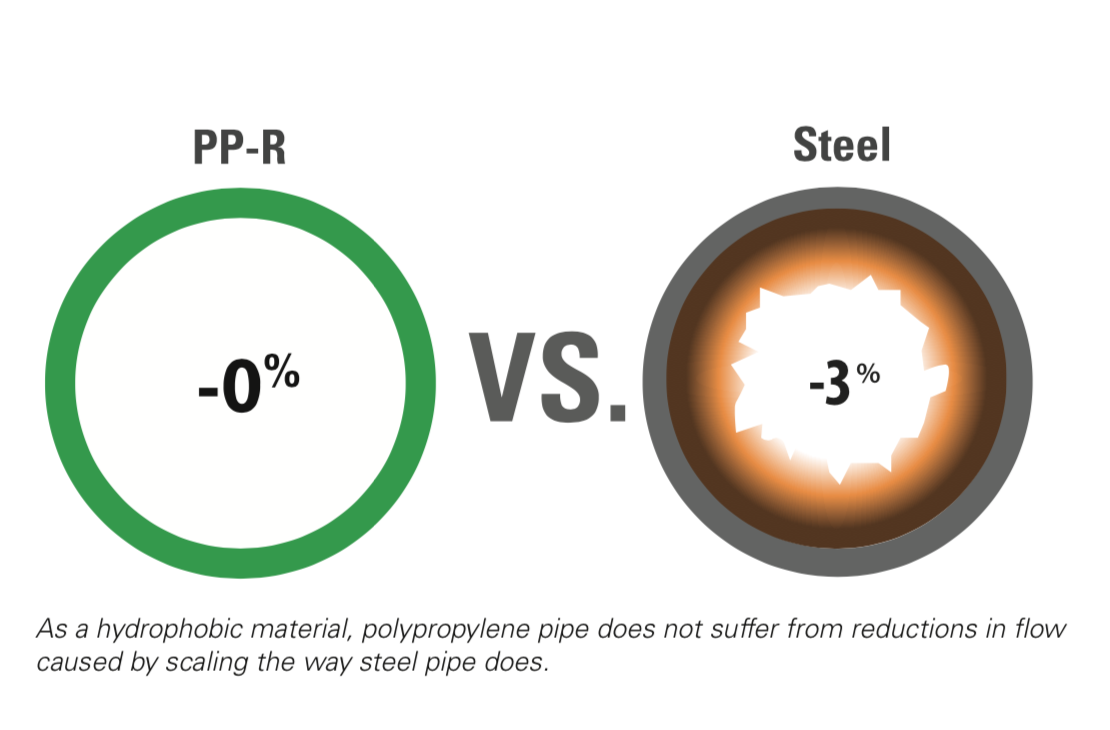
Polypropylene piping is ideal for these applications for reasons that directly impact the efficiency and longevity of a grow facility. First, the inner walls of polypropylene pipe are uniquely smooth, resulting in reduced friction losses, reducing pump energy consumption. The friction losses of polypropylene start out low and remain low for the life of the system because the pipe is not susceptible to rust or scale. Steel, copper and other metals do rust and corrode over time, increasing friction losses and the pump energy required to overcome those losses.
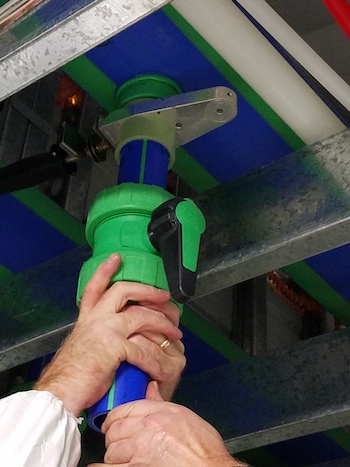
Socket fusion (shown here) is one method of heat-fusing polypropylene pipe and fittings.
Polypropylene pipe also can be used in conjunction with geothermal heat pump systems which are frequently applied in agriculture. Geothermal systems rely on the earth or a body of water as a heatsink and/or heat source for highly efficient transfer of heat to and from the growing spaces for space conditioning and agricultural processes. In these applications, polypropylene pipe transports the heating and/or cooling fluid from the central energy source to forced-air equipment or a radiant distribution loop. The pipe can be buried in the ground and/or concrete floors without the need for any protective sleeves or wrap.
Another strategy that grow facilities often use to reduce their energy consumption is heat reclaim. In these applications, polypropylene pipe can be used to transfer energy to or from process water, wastewater, or any other source that can be used to pre-heat or pre-cool water for other heating, cooling or process needs. This gives growers the opportunity to fully optimize whatever resources are available to them – whether it be the sun, a nearby lake, or even a nearby wastewater treatment plant. It’s all been done with polypropylene.
Specialized Growing Strategies
Not all commercial cannabis is grown in soil. Some is grown hydroponically with plant roots submerged in a nutrient-rich solution of water and fertilizers while others are grown aeroponically with roots suspended in air, drawing nutrients from a sprayed mist. These grow strategies very often rely on high purity water (typically reverse osmosis or deionized water) when existing water sources are determined unsuitable.
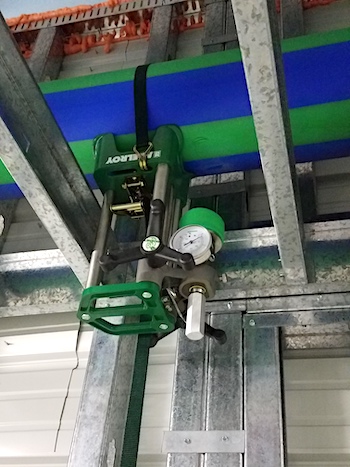
Versatile fusion tools allow polypropylene pipe to be heat- fused in spaces in which welding metal pipe would be difficult or impossible.
High purity water automatically limits piping options. Copper should never be used with deionized water because if the fluid’s pH levels fall below 6.5, corrosion may occur and copper molecules can leach into the supply. Although stainless steel piping is an option for these applications, it is often cost-prohibitive and it, too, will leach over time if the water should become too acidic or too alkaline. Polypropylene is ideal for these applications because it does not leach, and its installation never requires the use of any potential contaminants such as solder, flux or glue. It can even be used for potable water and food processing since it is available in formulations that meet both NSF 51 and NSF 61.
Facilitating Construction and Expansion
Growers and owners are typically under a lot of pressure to quickly get grow facilities operational so they can begin the journey from seed to profit as soon as possible. Construction schedules are always a challenge, particularly when it comes to mechanical components like piping. Installing metal pipe requires licensed welders (expensive and increasingly scarce) as well as special permitting for the use of open flames on a jobsite. In addition, maneuvering heavy sections of metal pipe into existing structures and then supporting it so it can be welded into place is both logistically and physically challenging. Under these circumstances, a seemingly trivial error like a miscalculation in metal pipe length can put a project several days (if not weeks) behind schedule.
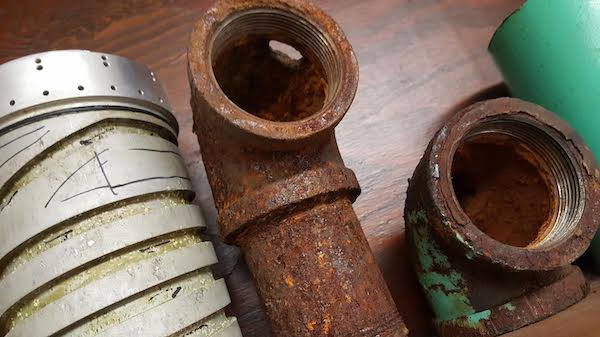
Polypropylene pipe is hydrophobic and will never scale and corrode the way metal pipe does.
Opting for polypropylene pipe keeps these jobsite nightmares at bay for the following reasons:
- Polypropylene is lightweight – especially helpful in greenhouses where structural support is limited
- Polypropylene fittings can be prefabricated offsite in controlled areas so that jobsite fabrications are minimized – some manufacturers even offer fabrication services
- Improper lengths can usually be amended at the jobsite with little disruption to work schedules
- The pipe’s maneuverability compared to metal means it can be better negotiated in tight spaces
If an owner has hopes to expand the facility in the future (as many do), polypropylene piping systems are much easier to build out than metal pipe. Strategically located shut-off valves make it easy to isolate flow and cut into existing pipe to create new connections with minimal disruption to current operations. Fusion outlets allow for easy and relatively inexpensive expansions and one manufacturer offers a hot tap solution. Again, no flames or permits are required.
Beer There, Done That
If cannabis entrepreneurs need relevant examples of all that polypropylene can do, they need only look as far as the craft brewing industry. Craft brewers, an intensely collaborative group, have solidly embraced polypropylene for all that it has to offer, most notably its purity, sustainability, and fast and flexible installation – interests that closely parallel those of the cannabis industry.
“The word of mouth in the craft brewing industry is amazing, so we’ve had tremendous growth from breweries using it, not just for the glycol lines but in their heating and cooling applications, their geothermal applications, their domestic water supply, CO2, compressed air applications and beyond,” said Barry Campbell, VP of Marketing at Aquatherm, a leading manufacturer of polypropylene pressure piping systems.

A properly executed heat-fusion on polypropylene pipe creates a single piece with no leak paths.
According to Campbell, the fact that polypropylene is among the most environmentally friendly piping systems available has helped Aquatherm gain favor among craft brewers. One polypropylene pipe manufacturer has also done the certification work to allow the product to contribute to LEED v4 credits in the U.S. Green Building Council’s (USGBC) program.
An interest in sustainability is just one of the many commonalities that exist between the cannabis and brewing industries. Like so many newly incorporated cannabis growers, many craft brewers begin their entrepreneurial journey in the shell of a vacated building where existing infrastructure can challenge piping installations. The building or parking lot next door is “Phase II” of their venture. Finally, owners are often the same people brewing the beer or growing the cannabis, so they tend to be more hands-on in the selection of mechanical equipment. They do their own research and tend to look outside the box for ways to conserve energy.
Robert Millspaugh, operations supervisor at Flathead Lake Brewing Company in Bigfork, Montana, did extensive research on what piping to use for the process side of the brewery before ultimately choosing polypropylene. Flathead Lake, born from the ruins of an old bowling alley, installed several thousand feet of polypropylene to transport both heating water and glycol for heating, cooling, and process applications. Part of the system even uses clean effluent from a nearby water treatment plant to indirectly pre-temper process water for better efficiency.
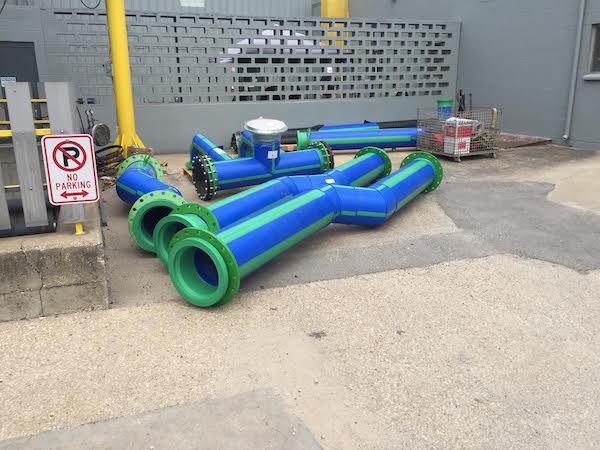
“We were looking for products that would help us achieve a LEED certification and [polypropylene] had a lot to offer. I also came across an article on Epic [Brewing Company in Salt Lake City] and how they used [polypropylene] in a renovation and discussed the product with the brewer there,” said Millspaugh.
Polypropylene also has been used successfully in brewing applications that require piping for food-grade and potable water.
Avondale Brewing Co., in Birmingham, AL was the first North American brewery to use Aquatherm’s food-grade (NSF-51) polypropylene pipe to transport beer from vessels in the main brewery to its packaging building where it is kegged, canned and bottled. The piping, which also is NSF-listed for potable water, is cleaned and sanitized between uses. Of course, like all of the manufacturer’s polypropylene systems, the piping is guaranteed to be free of heavy metals and toxic chemicals.
Cleanliness is a high priority in breweries and is one of the main reasons Founders Brewing Co. in Grand Rapids, MI, decided to use polypropylene in a heat reclaim process that taps heat from the brewing process to pre-heat outdoor air before it enters the building’s HVAC system. The piping is wash-down rated, so the brewer can keep the brew facility sparkling clean.
Examples like these demonstrate the potential for polypropylene piping in the cannabis industry.
“The craft brewing industry and everything it has been able to do with our pipe has created an unexpected blueprint for cannabis growers and how they can use polypropylene to facilitate construction, save energy and be more sustainable,” said Campbell.
[1] New Frontier Data, 2018 Cannabis Energy Report. Scale Microgrid Solutions and Resource Innovation Institute, co-authors. https://newfrontierdata.com/product/2018-cannabis-energy-report/
[2] Surna, Sustainability for Your Indoor Garden (blog) https://surna.com/sustainability-for-your-indoor-garden/
